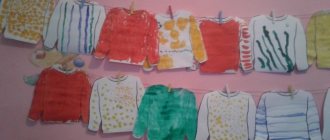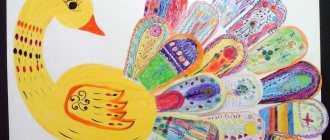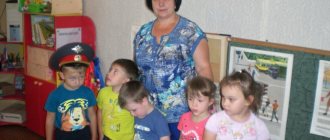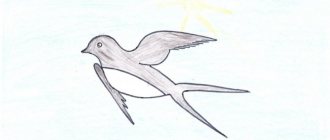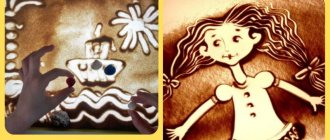Drawing. Notes for drawing lessons, GCD in the middle group
ECD for drawing with children of the middle group 4 years old “My friend the snowman” ECD for drawing with children of the middle group 3-4 years old “My friend the snowman”
Goal: To develop the artistic and creative abilities of children. Objectives: To train children in
drawing round objects.
Learn to convey in a drawing the structure of an object consisting of several parts. Call. Publication “Summary of a lesson on drawing in non-traditional techniques “Mimosa for. »
Program content: 1. Expand children's understanding of mother's holiday and the tradition of congratulating them on this day. Teach children to draw in an unconventional way: by poking with a stamp. To consolidate knowledge and ideas about color (yellow, shape (round), quantity (many, quality.
Article “Lesson summary using non-traditional drawing techniques in. » Summary of a lesson using non-traditional drawing techniques in the middle group on the topic: “My hand is my family” Compiled by: teacher Baytanaeva A.M. Bishkek – 2022 Program content: • Attract children to the fine arts using non-traditional techniques.
Summary of GCD for drawing in the middle group “Filimonovskaya horse, cat”
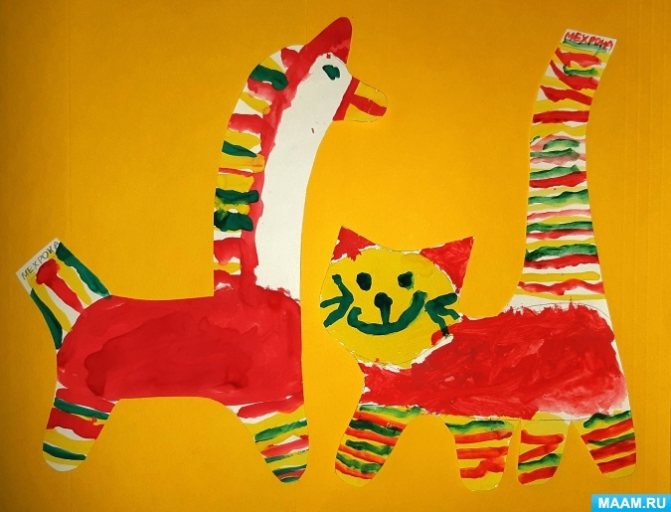
Goal: to teach how to convey the characteristic elements of Filimonov painting. Objectives: 1. Teach children to paint the silhouette of a Filimonov toy, alternating horizontal straight stripes. 2. Cultivate interest in the works of folk craftsmen 3. Develop independence and accuracy when working.
Summary of GCD for drawing in the middle group “Wagon”
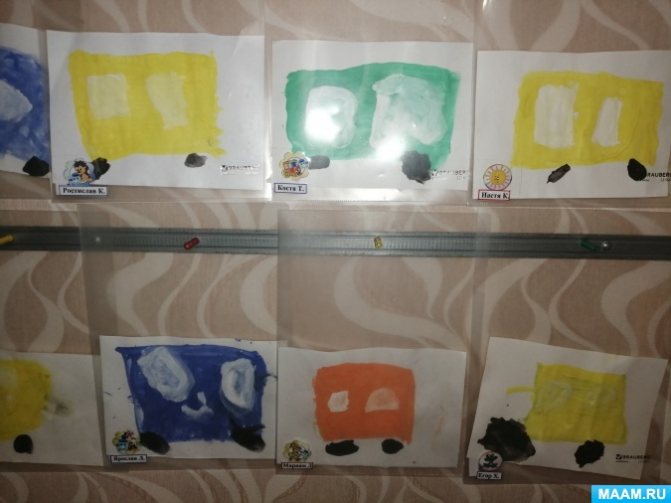
Drawing in the middle group “Wagon” Program content. Teach children to depict the rectangular shape of a carriage and the square shape of a window in a drawing; draw the object large, in accordance with the size of the sheet of paper; follow the rules for painting with paints (paint in one.
Notes on drawing "Girl in a fur coat" in the middle group Drawing lesson in the middle group "Girl in a fur coat" Program objectives: Continue teaching children to draw round, triangular and oval objects. Continue to teach children how to navigate in space on a piece of paper. Enrich children's vocabulary, develop coherence.
Source
Summary of an art lesson with children of the middle group “Subject drawing from life “Rowan Twig”
Elena Druzhinina
Summary of an art lesson with children of the middle group “Subject drawing from life “Rowan Twig”
Ministry of General and Vocational Education
GBPOU SO "Revda Pedagogical College"
Summary of GCD
on organizing productive activities
with middle school children
Subject drawing from life “ Rowan branch ”
Completed by: Druzhinina E. N.
Retraining course attendee
Subject drawing from life “ Rowan ”
Goal: learn to draw a sprig of rowan with berries using the technique of dipping, drawing with the tip of a brush...
1. fine art - improve the ability to depict an object from life - a rowan branch
2. color - teach how to choose colors correctly
3. compositional - continue to teach how to correctly place an image on a sheet of paper in accordance with their real location,
4. technical - exercise the ability to convey the proportions of objects
5. evoke an emotional and aesthetic response to the topic of the lesson .
Educational: develop a sense of rhythm and color, composition in the process of using various techniques, develop fine motor skills of the hands.
Educational: to cultivate interest in visual arts, love for nature and respect for it, to cultivate neatness
Integration of educational areas: cognition, artistic creativity.
Types of children's activities: play, communication, work, productive, musical and artistic.
Materials for the teacher: A sprig of rowan with berries , an A4 sheet, a brush, paint, a glass of water (if you need to show the technique)
Materials for children: Napkin, brushes, watercolor paints of different colors , sippy cup with water, A5 sheet, cotton swabs.
TSO: Audio recording (music for independent activities of children)
Preliminary work:
2. looking at rowan
3. reading poems, stories, looking at illustrations.
4. listening to music. works “Why are you standing swaying like a thin rowan tree.... ”
5. dance round dance " Rowan "
“Methods of teaching subject, plot, decorative drawing in different age groups”
«Methods of teaching subject, plot, decorative drawing in different age groups"
Mastering visual activities in kindergarten is of great importance for a child: a preschooler gets the opportunity to independently create a drawing, create a positive emotional mood, and contributes to the development of creativity, aesthetic sense, imaginative ideas and imagination. Drawing is perhaps the most interesting activity for preschool children. Visual activity allows children to express in drawings their idea of the world around them, their understanding of it and their attitude towards it. Drawing for a child is a unique form of knowledge of reality, the surrounding world, comprehension of artistic art, and therefore requires in-depth study, prediction and correction of children's education.
The visual activity of preschoolers as a type of artistic activity should be emotional and creative in nature. And the teacher creates all the conditions for this: he provides an emotional and imaginative perception of reality, forms aesthetic feelings and ideas, develops imaginative thinking and imagination. If previously it was believed that it was necessary to teach children using ready-made samples and showing how to execute drawings, now nurturing the creative independence of children has become one of the most important tasks of teaching [6, p.98].
In his research N.P. Sakulina notes that drawing, which a child masters so early, influences the formation of various aspects of personality. Since the essence of drawing is to depict objects and phenomena of the real world, its importance for mental development is great. Drawing also has a specific figurative form of reflection, which allows the child to develop artistic and creative abilities that can be used in various areas of life.
Therefore, it is obvious that in teaching children to draw, the task of developing creative independence and activity in children comes first. Teaching children to draw should be aimed primarily at developing their creative independence and activity. And for this it is necessary to cultivate in children the ability to see objects and phenomena around them that serve as the content of visual creativity, to evoke an aesthetic attitude towards social events and nature, to develop the emotional responsiveness of children and to equip them with means of depicting various events and phenomena [2, p.63] .
Drawing in childhood has a huge impact on the comprehensive development of the child’s personality and, above all, on his aesthetic development. It is important at this age to bring the child to an understanding of beauty, to develop the ability to create beauty himself, and to cultivate aesthetic feelings (feelings of shape, color, composition). Drawing classes teach the child to act independently and to be busy.
1.Types of drawing in preschool
In kindergarten, drawing takes a leading place in teaching children the fine arts and includes three types: drawing of individual objects, plot and decorative. The main task of teaching drawing is to help children understand the surrounding reality, develop their powers of observation, cultivate a sense of beauty and teach techniques of depiction; at the same time, the main task of visual activity is carried out - the formation of children’s creative abilities in creating expressive images of various objects using visual means available for a given age [9, p.72].
- Methods of teaching subject drawing
A competent, realistic depiction of an object in a drawing involves the transfer of characteristic shape and details, the proportional relationship of parts, perspective changes, volume, movement, and color.
Research by domestic psychologists has shown that in the perception of an object, the main defining feature is the form, which helps the child to distinguish one object from others. Errors when depicting a form are explained not so much by incorrect ideas and lack of skills, but by the inability to correctly perceive the subject analytically. Since the child’s visual skills are still very imperfect, he also faces visual difficulties. In the drawing, the shape is limited by a linear outline. But, at the same time, correctly drawing lines and depicting a contour in the first steps of working on a drawing cannot serve as a primary task. You cannot draw a line around a contour if the general form has not yet been found, since it is always unstable, changeable, and tracing it is the result, the final stage of the drawing [3, p. 178].
The artist, when depicting an object, starts from a sketch of the basic form. This type of image is difficult for a preschooler, especially a 3-4 year old. He cannot imagine the entire object in its entirety in the relationships of all its parts. It is easier for him to draw an object sequentially, part by part. This method makes the child’s work easier - after finishing one part, he remembers or sees in nature what follows next, and draws it. It is gradually necessary to teach children to start drawing from a general sketch, since working in parts has its own complexity, which makes it difficult to convey the correct form - identifying the main parts and secondary ones, their proportional relationships and location in space [5, p. 127]. The general objectives of learning to draw individual objects for all age groups are the following:
- teach how to depict the shape and structure of an object, convey the proportional relationships of parts, changes due to simple movement;
- teach the depiction of some characteristic details that make the image expressive and imaginative;
- convey the color of an object in accordance with its content and the nature of the image;
— develop technical skills in drawing with pencils, paints and other materials.
- Methods of teaching plot drawing
The main goal of plot drawing is to teach a child to convey his impressions of the surrounding reality. It is known that all surrounding objects are in a certain connection with each other. The attitude towards an object or phenomenon largely depends on the understanding of this particular connection.
The ability to establish semantic connections between various objects and phenomena develops gradually in the child. Therefore, plot drawing for educational purposes is introduced no earlier than in the middle group, first as an image of 2-3 objects located nearby. Naturally, children should know the techniques for depicting objects that are the main characters in the plot, otherwise difficulties in depicting unfamiliar objects will distract them from completing the main task. However, plot drawing should not be limited to depicting only those objects that children have already depicted [1, p.53].
The ability to highlight the main thing in a plot is associated with the development of perceptions and analytical-synthetic thinking. In a small child they are still too superficial. He, first of all, perceives what is directly accessible to sight, touch, and hearing, and often recognizes an object by some insignificant details that he remembers. In the same way, a child perceives and conveys the plot in a drawing. Highlighting the main thing, understanding the relationships and connections of plot objects are quite difficult tasks for a preschooler. They can be solved by children of the older group [3, p.79].
In plot drawing, it is important to correctly convey the proportional relationships between objects. This task is complicated by the fact that when depicting a plot, it is necessary to show not only the difference in their sizes that exists between them in life, but also the increase or decrease of objects in connection with their location in space. To do this, the child must be able to compare and contrast image objects, and see the semantic connection between them.
The general objectives of teaching story drawing in kindergarten are the following:
- develop the ability to convey the content of a topic and highlight the main thing in it;
- develop the ability to convey interactions between objects;
- develop the ability to correctly convey proportional relationships between objects and show their location in space.
- Methods of teaching decorative drawing
Decorative drawing, like all types of fine arts, develops a child’s sense of beauty. Works of folk decorative art are close to children due to their colorfulness and simplicity of composition.
By introducing children to works of decorative art from various regions and nationalities of our country, the teacher must instill in the children a love for the Motherland and respect for the work of the people who create this beauty [6, p.85].
A teacher teaching children decorative drawing faces the following tasks:
- develop a sense of composition in connection with the construction of patterns on various forms;
- develop a sense of color;
- develop the ability to distinguish between styles in the decorative arts and use their individual elements in your creativity;
— improve technical skills in drawing with a brush and pencil.
When teaching children decorative drawing, the teacher must develop in them the ability to see the relationship between all components of the pattern, color, composition, and elements of form. Children, getting acquainted with decorative drawing, must learn to clearly imagine what rhythm and symmetry are, without which decorative art cannot exist [5, p.147].
In decorative painting, developing a sense of color stands out as an important task. Color in a painted ornament is closely related to composition; in a pattern they are inseparable from each other. The task of using color in decorative painting becomes more complex in each group, starting with the brightest, most contrasting combinations and ending with shades of warm and cool colors in different combinations.
Thus, in preschool institutions, three types are used in teaching children to draw: drawing of individual objects, plot and decorative. Each of them has specific tasks that determine the program material and the content of work in each age group.
2. Features of teaching preschoolers to draw in different age groups
Visual activities are included in the pedagogical process of a preschool educational institution from the first junior group. When guiding it, it is important to remember the conditions common to all age groups that are necessary for children to successfully master visual arts and develop their creativity. Formation of sensory processes, enrichment of sensory experience, clarification and expansion of ideas about those objects, objects and phenomena that they are to depict. Taking into account the individual characteristics of children, their desires and interests.
- The first junior group (1.5-3 years).
The most accessible type of visual activity for children of this age is drawing. It is important to arouse interest in activities with pencils, paints, and felt-tip pens. Children should be drawn to the fact that a pencil, brush, or felt-tip pen will leave a mark on the paper if you run the sharpened end of a pencil or brush over it.
One of the main tasks of the teacher is to teach children to hold a pencil, brush, or felt-tip pen correctly: with three fingers, not very close to the sharpened end or nap, without squeezing them tightly with your fingers. For a child, this task is perceived as personally significant: a child of this age wants to learn everything correctly so that it turns out beautifully.
As children master drawing with pencils, you can give children paints and a brush. Children should be encouraged to draw a variety of objects that surround them and attract attention while playing, observing while walking, looking at them, or tracing the outline of an object with their hands. It is advisable to draw with sticks on the ground, on the snow, or with chalk on a blackboard, encouraging children to act with one hand or the other. Drawing should be free, i.e. There is no need to rush into teaching children how to depict objects of a certain shape. It has been noticed that children quickly form stereotypical actions and develop the habit of drawing only these objects and only in the way the teacher showed them. This narrows the subject matter of the images a child can create; as a result, even when children have the opportunity to draw freely, they will repeat what they have learned earlier. A completely different picture emerges when children, from the very beginning, have the opportunity to freely reflect in the drawing what they want: the content of the drawings becomes more varied and interesting. Children depict objects (car, sun, doll, bird, fish, hare, etc.) that, as a rule, do not work with the traditional method (when children are asked to draw lines and objects of a certain shape) [10, p.74].
- Second younger group (3-4 years old).
Children of this age need to develop the ability to listen to the teacher, create an image given by him or invented by themselves, evaluate the resulting result, and enjoy it. To improve visual skills, you should continue to develop your perception: learn to isolate an object from the environment, trace it with your hands (one or the other) along the contour, or clasp it with your hands to feel the volume (this will help to know the shape of the object and convey it in the image). In the process of perceiving objects, the teacher encourages children to identify and name their shape (round, square, triangular), color; teaches you to distinguish and name at least five or six colors. As a result, children have a desire to choose an object of a certain shape, color, etc. One should encourage the addition of a story to the created image, the desire to hear an adult’s assessment of one’s work, and the expression of interest in the drawings of other children [3, p. 174].
Children of this age are taught to draw objects that have one part (they start with them) or several parts. The objects offered to children for depiction may be different. The teacher can present them, children can choose them themselves at will. This increases their interest and desire to take up drawing. Interest in drawing is enhanced by the inclusion of fairy-tale images (bun, turnip) and the creation of playful incentives. During classes, children should be encouraged to create several images in order to more easily remember drawing methods and then act more freely and confidently [10, p.83].
In the process of drawing, children's activities must be accompanied by nursery rhymes, riddles, and music. This will help develop their emotional responsiveness when perceiving pictures and illustrations. Children’s attention should be paid to expressive means [2, p.63].
- Middle group (4-5 years old).
Children of the fifth year of life should develop aesthetic perception, aesthetic figurative ideas, imagination, artistic and creative abilities, the ability to examine objects (including with hand movements in shape), name shape, color (and its shades), size (as an object in whole and parts). In one lesson, it is advisable to offer to draw not one, but several objects of the same shape. By depicting the same object several times, children involuntarily change their size and position in space and at the same time gain confidence and freedom of movement, which contributes to the manifestation of creativity. Subjects for drawing should be offered only taking into account the children’s impressions (what they saw interesting, what they were read, what they were told, what cartoons they watched, etc.). You can invite them to draw what they themselves want (by design). In this case, children’s attention should be paid to the location of the images on a sheet of paper: at the bottom there is a strip of earth, grass, snow, water, on the entire surface of the sheet there is a forest clearing, a snow field, etc.
- Senior group (5-6 years old).
The visual activity of 5-year-old children is becoming increasingly conscious and intentional. They begin to develop an interest in this activity. The child’s sensory experience is enriched, the ability to analyze perceived objects, compare them with each other, and establish similarities and differences develops. Children can already be taught to convey in an image not only the basic properties of objects, but also characteristic details, the ratio of parts in size relative to each other.
An adult must teach the child to detail everything perceived, including movements, and to pay attention to the position of parts of an object in space. To create expressive images, you need to continue to develop your perception of color. The development of a sense of color is facilitated by decorative drawing, images of flowers, fairy-tale birds, palaces, etc. Children’s attention should be paid to the fact that the position of the sheet of paper on which they create the drawing must correspond to the proportions of the depicted object: if the object is tall, the sheet of paper must be positioned vertically , and if extended in length - horizontally. This is the only way the drawing will look beautiful [2, p.73].
By placing an image on a sheet of paper, children master the simplest compositional skills: they can already place images in one plane (on the strip at the bottom of the sheet), but it is much more difficult, but also more beautiful, to arrange images across the entire sheet of paper in two or three plans, conveying perspective. In order for children to learn how to freely depict any objects and phenomena that interest them in a drawing, they need to be introduced to different drawing techniques and different visual materials. Children in the older group, when creating images, use various previously acquired skills to paint with a brush: wide lines - with the entire bristle, thin lines - with the end of the brush, strokes - by applying the entire bristle of the brush. Such techniques can be used both in subject and decorative drawing. [5, p.127].
- School preparatory group (6-7 years old).
During drawing classes, children in their seventh year depict objects, scenes, landscapes, and create decorative compositions. When teaching how to convey a plot, the teacher draws children’s attention to the location of objects in space in relation to each other (which is closer, which is further), the blocking of one object by another, the ratio of objects in size, color, and so on [3, p. 185].
In the preparatory group for school, teaching children technical and visual skills and abilities, on which the quality of visual images depends, as well as a positive emotional attitude towards drawing remain important. At this stage, the teacher teaches children to notice the beauty of the created image, i.e. shape, smoothness, unity, thinness, elegance of lines, rhythmic arrangement of lines and spots, uniform shading of the picture, smooth transitions of color shades resulting from uniform shading and correct regulation of pressure on the pencil.
Thus, each age period of preschool childhood has its own characteristics of the methodology for teaching drawing in a preschool institution.
Conclusion
So, it is advisable to build the process of creative development of preschool children taking into account a broad approach to solving this problem. At any age stage of preschool childhood, it is important to learn how to find an approach to any child, to be able to instantly respond to this or that situation that develops in class and in free activity.
As a result of studying the research topic, the following conclusions can be drawn:
• classes in visual arts (drawing) are a means of educating children in the preschool period;
• drawing classes are part of the multifaceted work of a kindergarten, therefore visual activity should be closely related to all aspects of educational and educational work, during which children receive a variety of impressions and knowledge;
• the relationship between drawing classes and other subjects of preschool education is of particular importance;
• the content, methodology and organization of visual arts classes should be aimed at developing children's creativity;
• drawing classes should be designed taking into account continuity between different age groups.
List of used literature
1. Grigorieva, G.G. Visual activities of preschool children / G.G. Grigorieva. - M.: Academy, 1997. - 112 p.
2. Kazakova, T.G. Develop creativity in preschoolers / T.G. Kazakova. – M.: Education, 2007. – 100 p.
